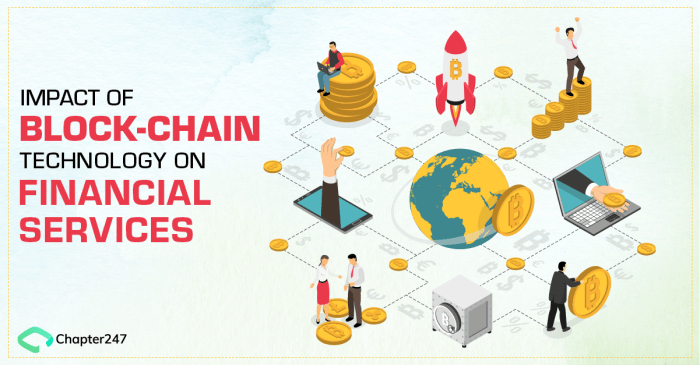How Blockchain Technology is Reshaping Financial Auditing marks a pivotal moment in the evolution of financial accountability. This transformative technology, with its inherent immutability and transparency, promises to revolutionize auditing practices, enhancing data security, streamlining processes, and bolstering trust in financial systems. The implications are far-reaching, impacting everything from fraud detection to regulatory compliance.
Blockchain’s decentralized ledger system offers a robust and secure platform for recording and verifying financial transactions. This eliminates the need for centralized intermediaries, reducing the risk of manipulation and enhancing audit trails. Furthermore, the integration of smart contracts automates various audit procedures, increasing efficiency and minimizing human error. This exploration delves into the specifics of this technological shift, examining both its advantages and challenges.
Introduction to Blockchain in Financial Auditing
Blockchain technology, initially known for its role in cryptocurrencies, offers transformative potential for financial auditing. Its decentralized, transparent, and immutable nature directly addresses many of the challenges inherent in traditional auditing practices, leading to increased efficiency, security, and trust. This section explores the fundamental principles of blockchain and how they are reshaping the financial auditing landscape.
Blockchain’s core functionality revolves around a distributed ledger—a continuously updated database shared among multiple participants. Each transaction is recorded as a “block,” cryptographically linked to the previous block, creating an unbroken chain. This immutability means that once a transaction is recorded, it cannot be altered or deleted, providing a highly secure and auditable record. The transparency aspect allows authorized parties to view the entire transaction history, enhancing accountability and reducing the risk of fraud.
Blockchain’s Impact on Traditional Auditing Processes
Traditional financial auditing relies heavily on manual processes, involving extensive documentation review and reconciliation. This can be time-consuming, prone to human error, and costly. Blockchain’s inherent immutability and transparency significantly streamline these processes. Auditors can directly access and verify the integrity of financial records stored on the blockchain, eliminating the need for extensive manual verification. This reduces the time and resources required for audits, allowing auditors to focus on higher-value analytical tasks. For instance, instead of manually reconciling bank statements, auditors can directly access the blockchain-based record of transactions, significantly reducing the time and effort involved.
Blockchain’s Enhancement of Data Security and Integrity
Data security and integrity are paramount in financial auditing. Blockchain technology offers robust mechanisms to enhance both. The cryptographic hashing and distributed nature of the blockchain make it extremely difficult to tamper with data. Any attempt to alter a record would be immediately detectable due to the cryptographic link between blocks. Furthermore, the distributed nature of the blockchain means that no single entity controls the data, reducing the risk of data breaches or unauthorized access. Imagine a scenario where a company’s financial records are stored on a blockchain. If a hacker attempts to alter a transaction, the change would be immediately apparent to all participants on the network, preventing the fraudulent activity from taking hold. This enhanced security translates to greater trust and confidence in the accuracy and reliability of financial records.
Enhanced Audit Trails and Traceability
Blockchain technology fundamentally alters the way financial transactions are recorded and audited, offering significant improvements in transparency and accountability. Its inherent immutability and cryptographic security create a robust and tamper-evident system, leading to more reliable and efficient audits. This enhanced audit trail significantly reduces the risk of fraud and improves trust in financial reporting.
Blockchain creates a comprehensive and auditable trail of financial transactions by recording each transaction as a block within a chronologically ordered chain. Each block contains a cryptographic hash of the previous block, linking them securely together. This chain of blocks, distributed across a network of computers, makes it virtually impossible to alter or delete individual transactions without detection. The distributed nature also prevents single points of failure or manipulation, enhancing the overall integrity of the audit trail.
Improved Traceability of Assets and Liabilities
Blockchain enhances the traceability of assets and liabilities by providing a clear and immutable record of their ownership and movement throughout their lifecycle. For example, tracking the provenance of goods in a supply chain becomes significantly easier. Each transaction, from raw material sourcing to final sale, is recorded on the blockchain, allowing auditors to verify the authenticity and origin of products. Similarly, tracking ownership of digital assets, such as cryptocurrencies or NFTs, is straightforward and transparent, eliminating ambiguities and disputes. In the financial sector, blockchain can improve the traceability of loans, securities, and other financial instruments, providing a more accurate and reliable picture of a company’s financial position. Consider a scenario involving the transfer of a bond; the blockchain would record each transfer, along with the date and time, creating a verifiable and complete history of ownership.
Real-Time Transaction Tracking
Real-time transaction tracking is a key benefit of blockchain in financial auditing. Traditional auditing often relies on batch processing and periodic reconciliation, leading to delays in identifying discrepancies or irregularities. Blockchain, however, provides immediate visibility into transactions as they occur. This real-time monitoring enables auditors to detect anomalies promptly, reducing the time and resources required for investigation. Furthermore, real-time tracking facilitates more efficient fraud detection and prevention, as suspicious activities can be identified and addressed immediately, rather than after the fact. For instance, a real-time audit of cryptocurrency transactions can immediately highlight any unusual patterns or potentially fraudulent activities.
Comparison of Traditional and Blockchain-Based Audit Trails
| Feature | Traditional Audit Trail | Blockchain-Based Audit Trail |
|---|---|---|
| Data Storage | Centralized databases, potentially vulnerable to manipulation | Decentralized and distributed ledger, highly secure and tamper-evident |
| Data Integrity | Relies on internal controls and periodic reconciliation, susceptible to errors | Cryptographically secured, ensuring data integrity and immutability |
| Transparency | Limited transparency, access often restricted to authorized personnel | Enhanced transparency, allowing authorized parties to view transaction history |
| Audit Efficiency | Time-consuming and resource-intensive, often involving manual processes | Automated and efficient, reducing audit time and costs |
Smart Contracts and Automation in Auditing
Smart contracts, self-executing contracts with the terms of the agreement between buyer and seller being directly written into lines of code, are revolutionizing financial auditing by automating various procedures and enhancing efficiency. Their immutable nature, stored on a blockchain, ensures transparency and reduces the risk of manipulation, making them a powerful tool for improving the accuracy and reliability of audits.
Smart contracts can significantly reduce human error and improve efficiency in auditing by automating repetitive tasks. This frees up auditors to focus on higher-level analysis and judgment, leading to more effective and insightful audits. The automation of data verification and reconciliation, for instance, minimizes the chance of manual errors and speeds up the overall audit process.
Smart Contract Applications in Financial Data Verification
Smart contracts can be designed to automatically verify financial data and transactions. For example, a smart contract could be programmed to compare data from a company’s accounting system with data from its bank statements. Any discrepancies would trigger an alert, allowing auditors to investigate promptly. Another application involves verifying the accuracy of invoices and payments. A smart contract could automatically cross-reference invoice details with corresponding payment records, flagging any inconsistencies. This eliminates the need for manual reconciliation, saving significant time and resources.
Example: Smart Contract for Auditing Expense Reimbursements
Consider a hypothetical smart contract designed to automate the auditing of employee expense reimbursements. The contract would be triggered when an employee submits an expense report. The report’s data, including dates, amounts, and descriptions, would be encoded into the contract. The smart contract would then:
- Verify that the expenses fall within the company’s approved expense policy, defined within the contract’s logic.
- Compare the expense report data with supporting documentation (receipts) stored securely on the blockchain or linked via a verifiable hash.
- Automatically approve or reject the reimbursement based on the verification results.
- Record the transaction details on the blockchain, creating an immutable audit trail.
This smart contract significantly reduces the manual effort involved in processing expense reimbursements, minimizes the risk of fraud, and ensures compliance with company policies. The immutable record on the blockchain also provides a transparent and auditable history of all transactions. Any discrepancies or irregularities are immediately identifiable, enhancing the efficiency and reliability of the audit process. The process could be further enhanced by incorporating OCR (Optical Character Recognition) technology to automatically extract data from receipts and input it into the smart contract. This would minimize the need for manual data entry, reducing the risk of errors and speeding up the entire process even further.
Addressing Fraud and Reducing Risks
Blockchain technology offers a transformative approach to financial auditing by significantly enhancing the prevention and detection of fraud. Its inherent features, such as immutability and transparency, create a robust system that minimizes vulnerabilities exploited by fraudulent activities. This section explores how blockchain contributes to a more secure and trustworthy financial landscape.
Blockchain’s decentralized and immutable ledger significantly reduces the risk of data manipulation, a cornerstone of many financial frauds. Traditional systems, relying on centralized databases, are susceptible to alteration or deletion of records by unauthorized individuals. Blockchain, however, distributes the data across a network of computers, making it incredibly difficult to alter information without detection. Any attempt to change a transaction would be immediately flagged as inconsistent with the rest of the blockchain, providing an auditable trail of all modifications.
Blockchain’s Role in Fraud Prevention and Detection
Blockchain’s impact on fraud prevention and detection stems from its core characteristics. The immutable nature of the ledger creates a permanent record of all transactions, making it nearly impossible to erase or alter evidence of fraudulent activities. Smart contracts, automatically enforcing predefined agreements, further reduce the opportunities for fraud by eliminating human intervention in critical processes. Real-time transaction tracking allows for immediate identification of anomalies and potential fraudulent behavior, enabling quicker responses and mitigation of losses. For instance, a discrepancy in a payment transaction recorded on a blockchain can be instantly detected, triggering an alert for investigation, preventing larger-scale fraud.
Comparison of Traditional and Blockchain-Based Fraud Detection
Traditional fraud detection methods often rely on post-incident analysis, using statistical models and anomaly detection techniques. These methods are reactive, meaning fraud is detected only after it has occurred, often leading to significant financial losses and reputational damage. Blockchain-based approaches, on the other hand, offer a proactive and preventive strategy. The real-time monitoring and inherent transparency of blockchain allow for early detection of suspicious activities, enabling timely intervention and preventing fraud before it escalates. For example, a traditional system might only detect a fraudulent payment after the funds have been transferred. A blockchain-based system, however, might detect inconsistencies in the transaction’s metadata during the processing stage, triggering an alert before the payment is finalized.
Blockchain’s Influence on Regulatory Compliance
The enhanced transparency and auditability provided by blockchain significantly simplify regulatory compliance in financial auditing. Regulatory bodies require detailed records of transactions for compliance purposes, and blockchain technology provides this readily available, tamper-proof data. This reduces the time and resources spent on compliance audits, improving efficiency and lowering costs. Furthermore, the immutability of blockchain reduces the risk of non-compliance, as any deviation from regulations would be instantly detectable on the ledger. This increased accountability can foster greater trust among stakeholders and enhance the overall integrity of the financial system. For example, compliance with anti-money laundering (AML) regulations can be significantly improved through the use of blockchain, allowing for easier tracking of funds and identification of suspicious activities.
Challenges and Limitations of Blockchain in Auditing

While blockchain offers transformative potential for financial auditing, its implementation isn’t without significant hurdles. Several challenges related to scalability, regulation, and technology itself need careful consideration before widespread adoption can be realized. Overcoming these obstacles is crucial for unlocking the full benefits of blockchain in the auditing field.
Scalability Issues and Large Datasets
Blockchain’s inherent limitations in processing large volumes of data present a significant challenge for its application in financial auditing. Many large enterprises generate massive datasets, and processing these through a blockchain network can be slow and expensive. The throughput of most existing blockchain networks is significantly lower compared to traditional database systems, leading to potential bottlenecks and delays in audit processes. For instance, a global financial institution with millions of transactions daily would struggle to efficiently manage this volume on a public blockchain without significant infrastructure investment and potential compromises to the speed and efficiency of the audit. This limitation highlights the need for improved blockchain scalability solutions, such as sharding or layer-2 scaling techniques, before widespread adoption in large-scale auditing can be feasible.
Regulatory Hurdles and Legal Considerations
The regulatory landscape surrounding blockchain technology is still evolving, creating uncertainty and posing significant challenges for its adoption in auditing. Different jurisdictions have varying approaches to the legal recognition of blockchain-based records and smart contracts. The lack of clear legal frameworks can hinder the acceptance of blockchain-based audit trails as legally valid evidence in disputes or regulatory investigations. Moreover, concerns regarding data privacy, compliance with existing regulations like GDPR, and the potential for misuse of blockchain technology need careful consideration and appropriate regulatory guidance. For example, the difficulty in determining responsibility for data breaches or errors on a decentralized blockchain network poses a significant legal hurdle.
Potential Solutions to Overcome Challenges
Addressing the challenges of blockchain implementation requires a multi-faceted approach involving technological advancements, regulatory clarity, and collaborative efforts. Improving blockchain scalability through solutions like sharding or layer-2 scaling is crucial. Simultaneously, clear regulatory frameworks and legal guidelines are needed to ensure the legal validity and admissibility of blockchain-based audit evidence. Furthermore, the development of robust security protocols and auditing standards specifically tailored for blockchain-based systems is vital. Finally, fostering collaboration between blockchain developers, auditors, and regulators is essential to navigate the complexities of implementation and ensure the responsible and effective use of blockchain technology in financial auditing. This collaborative effort can help establish best practices and address emerging challenges proactively.
Future of Blockchain in Financial Auditing
The integration of blockchain technology into financial auditing is still in its nascent stages, but its transformative potential is undeniable. The coming years will likely witness a significant expansion of its role, moving beyond pilot projects and into widespread adoption across various sectors of the financial industry. This evolution will be driven by ongoing technological advancements, increasing regulatory clarity, and a growing understanding of blockchain’s capabilities within the auditing profession.
Blockchain’s future in financial auditing hinges on its ability to address persistent challenges related to data integrity, transparency, and efficiency. As the technology matures and becomes more user-friendly, its adoption will accelerate, leading to more streamlined and robust audit processes. This section will explore predictions regarding the future role of blockchain, its potential evolution, and novel applications beyond traditional financial reporting.
Predictions for Blockchain’s Role in Financial Auditing
The future of blockchain in financial auditing is bright. We can expect a significant increase in the use of blockchain for various auditing tasks. For example, large accounting firms are likely to incorporate blockchain-based audit tools into their standard operating procedures within the next decade. This will lead to increased efficiency and a reduction in the time and resources required for audits. Furthermore, regulatory bodies may start mandating the use of blockchain for certain types of financial reporting, driving wider adoption. This could be similar to the current push towards digitalization of financial records in many jurisdictions. A conservative estimate suggests that at least 50% of large financial institutions will be utilizing blockchain-based auditing solutions by 2030.
Evolution of Blockchain Technology for Enhanced Auditing
Several technological advancements will further enhance blockchain’s applicability in auditing. Improvements in scalability will allow for the processing of larger volumes of data more efficiently, addressing a current limitation. The development of more user-friendly interfaces will simplify the integration of blockchain technology into existing audit workflows, reducing the learning curve for auditors. Furthermore, the emergence of privacy-enhancing technologies, such as zero-knowledge proofs, will address concerns around data confidentiality, allowing for secure and compliant use of blockchain in sensitive audit contexts. This evolution will resemble the progress seen in other technologies, where initial complexities are gradually overcome through innovation and refinement.
Potential Use Cases Beyond Traditional Financial Reporting, How Blockchain Technology is Reshaping Financial Auditing
Blockchain’s applications in auditing extend far beyond traditional financial reporting. For example, it can be utilized to verify the authenticity and provenance of digital assets, crucial for auditing in the rapidly growing cryptocurrency and NFT markets. Supply chain auditing can also benefit significantly from blockchain’s ability to track goods and materials throughout their journey, enhancing transparency and accountability. Similarly, in the realm of environmental, social, and governance (ESG) reporting, blockchain can provide an immutable record of a company’s sustainability initiatives, bolstering the credibility of ESG disclosures. These diverse applications demonstrate blockchain’s potential to revolutionize various auditing processes across different industries.
Projected Adoption Rate of Blockchain in Financial Auditing
The adoption of blockchain in financial auditing is expected to follow an S-curve pattern, characterized by slow initial growth followed by a period of rapid adoption and eventual plateauing. A projected timeline might look like this:
| Year | Adoption Rate (Percentage of Large Firms) | Key Developments |
|---|---|---|
| 2025 | 10-15% | Pilot projects and initial implementations in specific areas. |
| 2030 | 50-60% | Widespread adoption driven by regulatory pressures and technological advancements. |
| 2035 | 80-90% | Blockchain becomes a standard tool in financial auditing, integrated into most audit workflows. |
This timeline reflects a cautious yet optimistic outlook, acknowledging the inherent challenges while recognizing the powerful potential of blockchain to transform the financial auditing landscape. The actual rate of adoption may vary depending on several factors, including regulatory developments, technological advancements, and market acceptance.
Case Studies and Real-World Examples: How Blockchain Technology Is Reshaping Financial Auditing

The application of blockchain in financial auditing is still relatively nascent, but several real-world examples illustrate its potential and the challenges involved in its implementation. These case studies demonstrate diverse approaches to integration, highlighting both successes and failures, providing valuable lessons for future adoption. Analyzing these experiences allows us to better understand the practical implications and refine strategies for broader implementation.
Several financial institutions and auditing firms have experimented with blockchain technology, leading to a range of outcomes. Some projects have yielded significant improvements in efficiency and security, while others have encountered obstacles related to scalability, regulatory uncertainty, and integration with legacy systems. Examining these contrasting experiences offers crucial insights into the complexities of blockchain adoption within the financial audit landscape.
Discover more by delving into Best Accounting Tips for Sustainable Business Growth further.
Blockchain Implementation in Supply Chain Finance
Several companies have utilized blockchain to enhance transparency and traceability in supply chain finance. For example, a major food retailer implemented a blockchain-based system to track the origin and movement of its products. This allowed for real-time verification of sourcing information, improving accountability and reducing the risk of fraud. The increased transparency led to enhanced trust among stakeholders and streamlined audit processes. However, challenges included the initial cost of implementation and the need for widespread adoption across the entire supply chain.
Use of Blockchain for KYC/AML Compliance
Know Your Customer (KYC) and Anti-Money Laundering (AML) compliance is a significant burden for financial institutions. Blockchain technology offers the potential to streamline these processes by creating a shared, immutable record of customer identities and transactions. Some banks have piloted blockchain-based KYC solutions, enabling faster onboarding of new clients and reducing the risk of regulatory penalties. However, issues related to data privacy and regulatory compliance have hindered widespread adoption. Successfully implementing these systems requires careful consideration of data protection regulations and international standards.
Application of Blockchain in Securities Lending
Blockchain’s ability to provide secure and transparent record-keeping makes it suitable for applications in securities lending. Several institutions have explored using blockchain to track the movement of securities, improving the efficiency and reducing the risk of errors in the lending process. The immutable ledger provided by blockchain eliminates the need for multiple intermediaries, reducing costs and increasing speed. However, the complexity of integrating blockchain with existing securities lending systems and the need for standardization remain significant challenges.
Comparative Analysis of Blockchain Integration Approaches
| Case Study | Approach | Successes | Failures/Challenges |
|---|---|---|---|
| Supply Chain Finance | End-to-end blockchain platform for tracking goods | Improved transparency, reduced fraud, streamlined audits | High initial implementation costs, need for widespread adoption |
| KYC/AML Compliance | Shared blockchain database for customer identity verification | Faster client onboarding, reduced regulatory risk | Data privacy concerns, regulatory uncertainty |
| Securities Lending | Blockchain-based record-keeping for securities transactions | Increased efficiency, reduced errors, lower costs | Integration complexity, standardization issues |
Concluding Remarks

In conclusion, the integration of blockchain technology into financial auditing presents a compelling case for a more efficient, secure, and transparent future. While challenges remain regarding scalability and regulatory frameworks, the potential benefits – from enhanced fraud prevention to streamlined audit processes – are undeniable. As blockchain technology continues to evolve and mature, its impact on financial auditing will only deepen, fundamentally altering how we ensure financial integrity and accountability.
Helpful Answers
What are the key security advantages of using blockchain in auditing?
Blockchain’s decentralized and immutable nature significantly reduces the risk of data tampering and fraud. The distributed ledger makes it extremely difficult for any single entity to alter records without detection.
How does blockchain address scalability issues in auditing large datasets?
Several solutions are being explored, including sharding (partitioning the blockchain) and layer-2 scaling solutions, to improve the processing speed and capacity of blockchain networks to handle large datasets.
What are the regulatory hurdles for blockchain adoption in auditing?
Regulatory uncertainty surrounding the legal validity and enforceability of smart contracts and the overall governance of blockchain-based systems is a major obstacle to wider adoption.
What is the role of artificial intelligence (AI) in conjunction with blockchain for auditing?
AI can be used to analyze the vast amounts of data on the blockchain, identifying anomalies and potential fraudulent activities more efficiently than manual methods.








